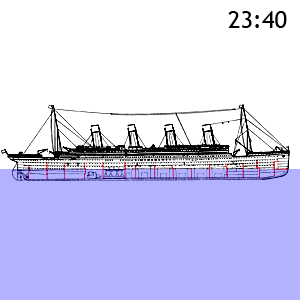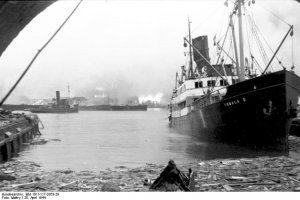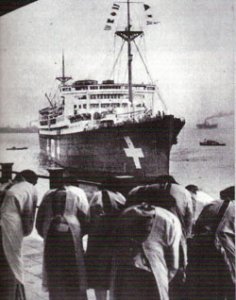Today in Naval History - Naval / Maritime Events in History
12th of April
please use the following link and you will find the details and all events of this day .....
1655 – Launch of HMS Royal Charles, an 80-gun first-rate three-decker ship of the line of the English Navy.
Royal Charles was an 80-gun first-rate three-decker ship of the line of the English Navy. She was built by Peter Pett and launched at Woolwich Dockyardin 1655, for the navy of the Commonwealth of England. She was originally called Naseby, named in honour of Sir Thomas Fairfax's decisive 1645 victory over the Royalist forces during the English Civil Wars. She was ordered in 1654 as one of a programme of four second rates, intended to carry 60 guns each. However, she was altered during construction to mount a complete battery of guns along the upper deck (compared with the partial battery on this deck of her intended sisters, on which there were no gunports in the waist along this deck), and so was reclassed as a first rate.

Royal Charles off Hellevoetsluis, captured by the Dutch after the Raid on the Medway, June 1667. Jeronymus van Diest (II).

1782 - Battle of Providien. British fleet under Vice-Admiral Sir Edward Hughes engaged a French fleet under the Bailli de Suffren near a rocky islet called Providien, south of Trincomalee, Ceylon.
The Battle of Providien was the second in a series of naval battles fought between a British fleet, under Vice-Admiral Sir Edward Hughes, and a French fleet, under the Bailli de Suffren, off the coast of India during the Anglo-French War. The battle was fought on 12 April 1782 off the east coast of Ceylon, near a rocky islet called Providien, south of Trincomalee.
1797 – Launch of HMS Sirius, a 36-gun fifth-rate frigate of the Royal Navy. Between 1797 and 1805,
HMS Sirius was a 36-gun fifth-rate frigate of the Royal Navy. Between 1797 and 1805, the Sirius was engaged in maintaining the blockade of Napoleonic Europe. She was lost in 1810 when her crew scuttled her after she grounded during the Battle of Grand Port.

The Sirius stranded on a coral shoal. Lithograph by A. Meyer (National Maritime Museum, London)

Scuttling of Sirius
1806 - HMS Brave (74), Cdr. Edmund Boger, foundered off the Azores in passage from Jamaica to England.
Cassard was a Téméraire-class 74-gun ship of the line of the French Navy. She was renamed Dix-août in 1798, in honour of the events of 10 August 1792, and subsequently Brave in 1803.

Scale model of The Thomson Collection of Ship Models on display at the Art Gallery of Ontario
1808 - Launch of HMS Venerable, a 74-gun third rate ship of the line of the Royal Navy, at Northfleet.

1823 - Launch of HMS Prince Regent, a 120-gun Caledonia-class first rate three-decker ship of the line of the Royal Navy, at Chatham.
HMS Prince Regent was a 120-gun first rate three-decker ship of the line of the Royal Navy, launched on 12 April 1823 at Chatham.
Served in the Baltic campaign in 1854 (1st campaign) but not in 1855 (2nd campaign).
She was converted into a screw ship in 1861, and was broken up in 1873.


1861 - The Civil War begins with Confederates firing on Fort Sumter, S.C.
The Union Navy plays an integral part blockading Confederates, keeping them diplomatically and economically contained from other nations.
The Battle of Fort Sumter (April 12–13, 1861) was the bombardment of Fort Sumter near Charleston, South Carolina by the Confederate States Army, and the return gunfire and subsequent surrender by the United States Army, that started the American Civil War. Following the declaration of secession by South Carolina on December 20, 1860, its authorities demanded that the U.S. Army abandon its facilities in Charleston Harbor. On December 26, Major Robert Anderson of the U.S. Army surreptitiously moved his small command from the vulnerable Fort Moultrie on Sullivan's Island to Fort Sumter, a substantial fortress built on an island controlling the entrance of Charleston Harbor. An attempt by U.S. President James Buchanan to reinforce and resupply Anderson using the unarmed merchant ship Star of the West failed when it was fired upon by shore batteries on January 9, 1861. South Carolina authorities then seized all Federal property in the Charleston area except for Fort Sumter.
1861 - Capture of Mỹ Tho
The Capture of Mỹ Tho (Vietnamese: Mỹ Tho) on 12 April 1861 was an important allied victory in the Cochinchina campaign (1858–62). This campaign, fought between the French and the Spanish on the one side and the Vietnamese on the other, began as a limited punitive expedition and ended as a French war of conquest. The war concluded with the establishment of the French colony of Cochinchina, a development that inaugurated nearly a century of French colonial dominance in Vietnam.

Capture of Saigon by France, 18th February 1859.
1910 – Launch of SMS Zrínyi, one of the last pre-dreadnought battleships built by the Austro-Hungarian Navy
SMS Zrínyi ("His Majesty's ship Zrínyi") was a Radetzky-class pre-dreadnought battleship (Schlachtschiff) of the Austro-Hungarian Navy (K.u.K. Kriegsmarine), named for the Zrinski, a noble Croatian family. Zrínyi and her sisters, Erzherzog Franz Ferdinand and Radetzky, were the last pre-dreadnoughts built by the Austro-Hungarian Navy.
During World War I, Zrínyi saw action in the Adriatic Sea. She served with the Second Division of the Austro-Hungarian Navy's battleships and shelled Senigallia as part of the bombardment of the key seaport of Ancona, Italy, during May 1915. However, Allied control of the Strait of Otranto meant that the Austro-Hungarian Navy was effectively contained in the Adriatic. Nonetheless, the presence of the Zrínyi and other battleships tied down a substantial force of Allied ships.
With the war going against the Austrians by the end of 1918, Zrínyi was prepared to be transferred to the new State of Slovenes, Croats and Serbs. On 10 November 1918, just one day before the end of the war, navy officers sailed the battleship out of Pola (Pula) and surrendered to a squadron of American submarine chasers. Following the handover to the United States Navy, she was briefly designated USS Zrínyi. In the Treaty of Saint-Germain-en-Laye, the transfer was not recognized; instead, Zrínyi was given to Italy and broken up for scrap.

12th of April
please use the following link and you will find the details and all events of this day .....
Naval/Maritime History - 27th of August - Today in Naval History - Naval / Maritime Events in History
Today in Naval History - Naval / Maritime Events in History Other Events on 11 April 1669 – Launch of french Fort 68, later 76 guns (designed and built by Jean Guichard, launched 11 April 1669 at Rochefort) – renamed Foudroyant in June 1671, broken up 1690 1693 – Launch of HMS Winchester...
shipsofscale.com
1655 – Launch of HMS Royal Charles, an 80-gun first-rate three-decker ship of the line of the English Navy.
Royal Charles was an 80-gun first-rate three-decker ship of the line of the English Navy. She was built by Peter Pett and launched at Woolwich Dockyardin 1655, for the navy of the Commonwealth of England. She was originally called Naseby, named in honour of Sir Thomas Fairfax's decisive 1645 victory over the Royalist forces during the English Civil Wars. She was ordered in 1654 as one of a programme of four second rates, intended to carry 60 guns each. However, she was altered during construction to mount a complete battery of guns along the upper deck (compared with the partial battery on this deck of her intended sisters, on which there were no gunports in the waist along this deck), and so was reclassed as a first rate.
Royal Charles off Hellevoetsluis, captured by the Dutch after the Raid on the Medway, June 1667. Jeronymus van Diest (II).
1782 - Battle of Providien. British fleet under Vice-Admiral Sir Edward Hughes engaged a French fleet under the Bailli de Suffren near a rocky islet called Providien, south of Trincomalee, Ceylon.
The Battle of Providien was the second in a series of naval battles fought between a British fleet, under Vice-Admiral Sir Edward Hughes, and a French fleet, under the Bailli de Suffren, off the coast of India during the Anglo-French War. The battle was fought on 12 April 1782 off the east coast of Ceylon, near a rocky islet called Providien, south of Trincomalee.
1797 – Launch of HMS Sirius, a 36-gun fifth-rate frigate of the Royal Navy. Between 1797 and 1805,
HMS Sirius was a 36-gun fifth-rate frigate of the Royal Navy. Between 1797 and 1805, the Sirius was engaged in maintaining the blockade of Napoleonic Europe. She was lost in 1810 when her crew scuttled her after she grounded during the Battle of Grand Port.
The Sirius stranded on a coral shoal. Lithograph by A. Meyer (National Maritime Museum, London)
Scuttling of Sirius
1806 - HMS Brave (74), Cdr. Edmund Boger, foundered off the Azores in passage from Jamaica to England.
Cassard was a Téméraire-class 74-gun ship of the line of the French Navy. She was renamed Dix-août in 1798, in honour of the events of 10 August 1792, and subsequently Brave in 1803.
Scale model of The Thomson Collection of Ship Models on display at the Art Gallery of Ontario
1808 - Launch of HMS Venerable, a 74-gun third rate ship of the line of the Royal Navy, at Northfleet.
1823 - Launch of HMS Prince Regent, a 120-gun Caledonia-class first rate three-decker ship of the line of the Royal Navy, at Chatham.
HMS Prince Regent was a 120-gun first rate three-decker ship of the line of the Royal Navy, launched on 12 April 1823 at Chatham.
Served in the Baltic campaign in 1854 (1st campaign) but not in 1855 (2nd campaign).
She was converted into a screw ship in 1861, and was broken up in 1873.
1861 - The Civil War begins with Confederates firing on Fort Sumter, S.C.
The Union Navy plays an integral part blockading Confederates, keeping them diplomatically and economically contained from other nations.
The Battle of Fort Sumter (April 12–13, 1861) was the bombardment of Fort Sumter near Charleston, South Carolina by the Confederate States Army, and the return gunfire and subsequent surrender by the United States Army, that started the American Civil War. Following the declaration of secession by South Carolina on December 20, 1860, its authorities demanded that the U.S. Army abandon its facilities in Charleston Harbor. On December 26, Major Robert Anderson of the U.S. Army surreptitiously moved his small command from the vulnerable Fort Moultrie on Sullivan's Island to Fort Sumter, a substantial fortress built on an island controlling the entrance of Charleston Harbor. An attempt by U.S. President James Buchanan to reinforce and resupply Anderson using the unarmed merchant ship Star of the West failed when it was fired upon by shore batteries on January 9, 1861. South Carolina authorities then seized all Federal property in the Charleston area except for Fort Sumter.
1861 - Capture of Mỹ Tho
The Capture of Mỹ Tho (Vietnamese: Mỹ Tho) on 12 April 1861 was an important allied victory in the Cochinchina campaign (1858–62). This campaign, fought between the French and the Spanish on the one side and the Vietnamese on the other, began as a limited punitive expedition and ended as a French war of conquest. The war concluded with the establishment of the French colony of Cochinchina, a development that inaugurated nearly a century of French colonial dominance in Vietnam.
Capture of Saigon by France, 18th February 1859.
1910 – Launch of SMS Zrínyi, one of the last pre-dreadnought battleships built by the Austro-Hungarian Navy
SMS Zrínyi ("His Majesty's ship Zrínyi") was a Radetzky-class pre-dreadnought battleship (Schlachtschiff) of the Austro-Hungarian Navy (K.u.K. Kriegsmarine), named for the Zrinski, a noble Croatian family. Zrínyi and her sisters, Erzherzog Franz Ferdinand and Radetzky, were the last pre-dreadnoughts built by the Austro-Hungarian Navy.
During World War I, Zrínyi saw action in the Adriatic Sea. She served with the Second Division of the Austro-Hungarian Navy's battleships and shelled Senigallia as part of the bombardment of the key seaport of Ancona, Italy, during May 1915. However, Allied control of the Strait of Otranto meant that the Austro-Hungarian Navy was effectively contained in the Adriatic. Nonetheless, the presence of the Zrínyi and other battleships tied down a substantial force of Allied ships.
With the war going against the Austrians by the end of 1918, Zrínyi was prepared to be transferred to the new State of Slovenes, Croats and Serbs. On 10 November 1918, just one day before the end of the war, navy officers sailed the battleship out of Pola (Pula) and surrendered to a squadron of American submarine chasers. Following the handover to the United States Navy, she was briefly designated USS Zrínyi. In the Treaty of Saint-Germain-en-Laye, the transfer was not recognized; instead, Zrínyi was given to Italy and broken up for scrap.




 Drydock and Shipbuilding.
Drydock and Shipbuilding.










